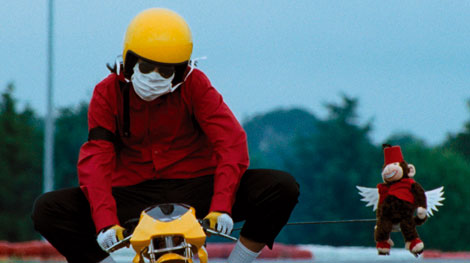
Directed by Harmony Korine
Written by Harmony Korine and Avi Korine
UK, France, Ireland, USA; 2007
A little over three years ago I was able to catch Harmony speaking at Ryerson University in Toronto. It was a fantastic Q & A session, hosted by Bruce LaBruce, who is awesome. Clips from Harmony's (ridiculously few) films played on the screen above the two, and it was the first time the filmmaker had actually watched any of the work since the bygone era in which he made it. He cringed, literally, after some of the harder-to-digest bits, but there was an unmistakably proud sparkle in those eyes as well. He mentioned a film in the works, a sad tale he was writing with his brother Avi, about celebrity impersonators living on a commune in France. Flash forward to last Saturday, when New York and I caught up with Mister Lonely, a film that's just exactly what he promised it would be. The shotgun semiotic technique—where art direction and a shooting script are replaced by a grocery list of iconic symbols—has been Harmony's signature in the past, and this newest piece may be a step removed from his first two films, but it's still a fine continuation of tradition. A young Buckwheat impersonator recalls many of the strange and semi-improvised Gummo performances, only this time feels more organic as a stand-in for Harmony himself, who was apparently raised on a hippie commune before his famous sojourn in New York City. Fate, free will, and personal choice comprise solid thematic ground on which much of the film rests, a nice change from the lily pond of content that makes up all of Harmony's other work. There are still a lot of nice Gummo moments, though, like the scene of Larry, Curly, and Moe shooting the sheep, or Sammy Davis Jr. dancing on the roof. In fact any scene including the impersonators, which is nearly every scene of the film, takes on the hyper-reality characteristic of Harmony's method. Other icons include The Pope, The Queen, and an Abe Lincoln who drops the F-bomb like it was slavery laws.
Werner Herzog makes another appearance, this time as an overzealous but well-meaning missionary somewhere in the Spanish-speaking jungle. See this film, if for no other reason than to experience his introductory scene—not so much a Harmony move, but more of a classic Herzog one. A local man (this is all documentary footage, I'm guessing, probably just a local Panamanian hanging around the set that they befriended) is prompted to confess his infidelity and plead forgiveness from Father Herzog, in costume with the camera rolling. The man eventually admits to having cheated on a woman, while tears stream down his cheeks. Herzog plays it straight, says a prayer in Latin, and absolves the man of all sin. Un-fucking-real. Next are the nuns, falling out of airplanes unscathed, basking in God's grace as they careen through the grainy blue sky on bicycles in some of the most beautiful photography of the film. Of the film? Try "of the year," for that matter. Cinematographer Marcel Zyskind is a usual Michael Winterbottom collaborator, and A propos, definitely take a look at both of these guys' work. Mister Lonely's photography is absolutely gorgeous, though. Highlight of the film by far. In the spirit of indulgence Zyskind goes old school, uses big-ass lenses, with shallow depths of field, loves slow motion, gets a little grainier than Gummo's Escoffier (may he rest in peace), but not as much as julien d-boy's Anthony Dod Mantle, a DP Zyskind worked for on 28 Days Later as it turns out. Take one look at the opening shot, Diego Luna's Dangerous-era Michael Jackson riding a tiny motorbike with a stuffed monkey attached to the back, all coming at you in ultra-slo-mo. Un-fucking-real.
Harmony spoke at Saturday's screening as well: "After tonight, I'm going to go home and write another movie. I'm not going to be so precious about things any more." In regards to his body of work, he took the words right out of my mouth. And in regards to the other movie, I'm certainly looking forward to it.
Awesome things I didn't mention:
Denis Lavant as Charlie Chaplin was great.
Leos Carax as a creep was perfect.
Samantha Morton gained weight for the Marilyn role, but she is still such a doll.
What was with the talking eggs?


